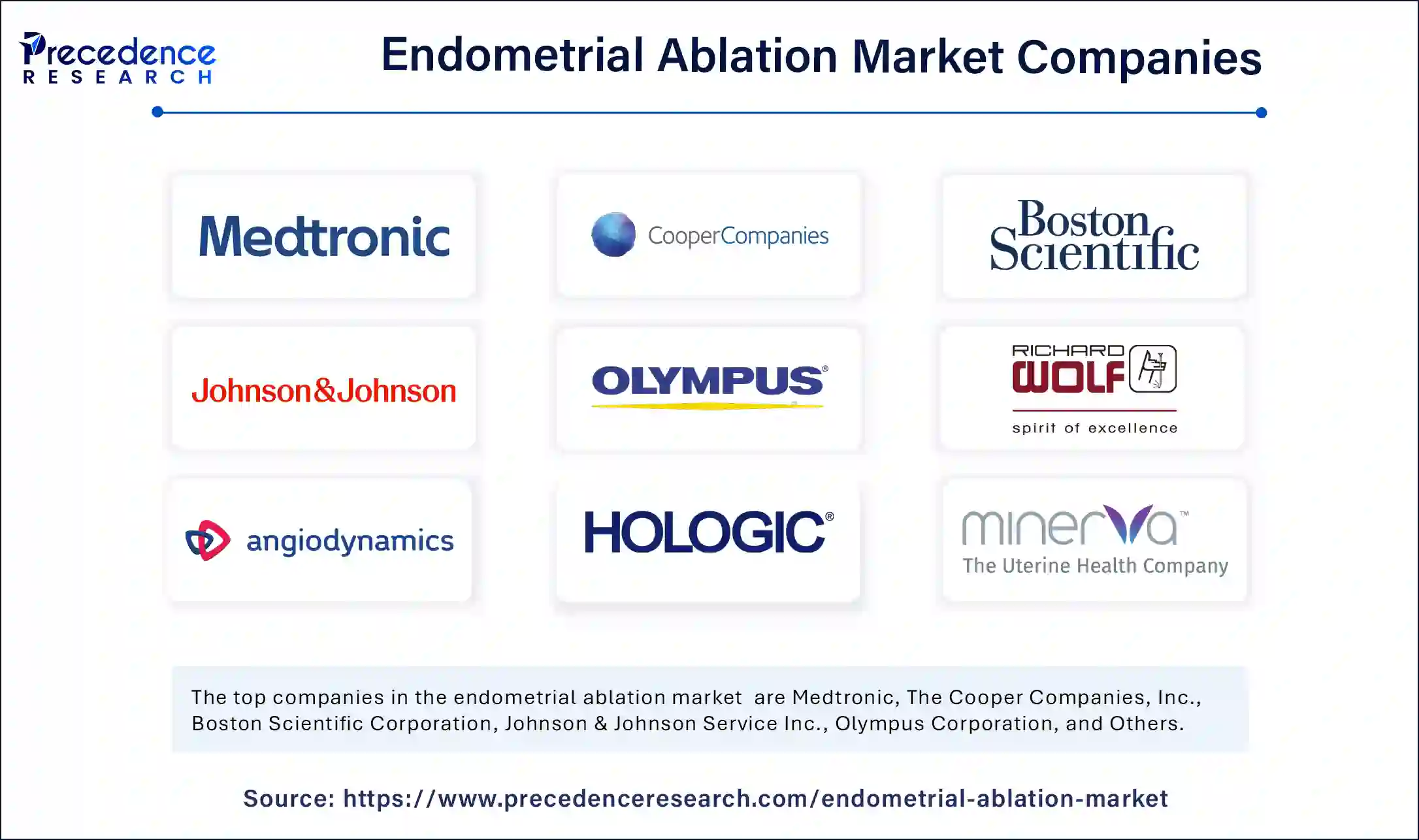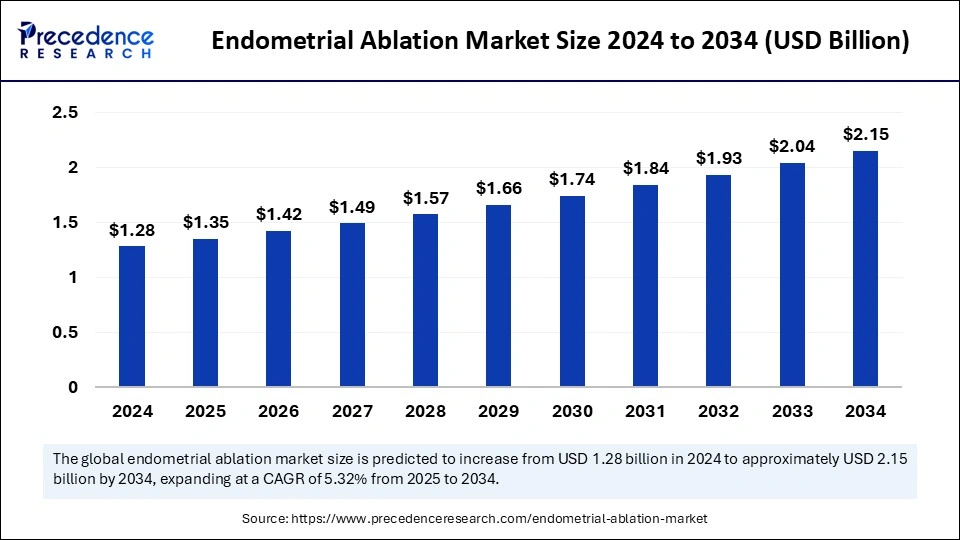The global endometrial ablation market size is estimated to worth around USD 2.15 billion by 2034 increasing from USD 1.28 billion in 2024, with a CAGR of 5.32%.
Endometrial Ablation Market Key Highlights
-
North America led the global market in 2024, holding a significant 32% market share.
-
Asia Pacific is expected to expand at a 5.7% CAGR over the forecast timeframe.
-
The radiofrequency ablation segment accounted for the highest market share of 57% in 2024.
-
The cryoablation segment is witnessing consistent growth, with a CAGR of 5.5% projected in the upcoming years.
-
Clinics emerged as the leading end-use sector, representing 54% of the total market share in 2024.
-
Hospitals are estimated to grow steadily at a 5.53% CAGR during the forecast period.
Get a Free Sample Copy of the Report@ https://www.precedenceresearch.com/sample/5744
Endometrial ablation is a minimally invasive medical procedure designed to remove or destroy the endometrial lining of the uterus. It is primarily used to treat abnormal uterine bleeding (AUB) in individuals who experience heavy menstrual periods that impact their quality of life. The procedure is an alternative to hysterectomy and is typically recommended for patients who do not wish to undergo major surgery and are not planning future pregnancies.
Procedure and Techniques
Endometrial ablation can be performed using various techniques, including:
-
Radiofrequency Ablation – Uses radio waves to generate heat, which removes the endometrial tissue.
-
Thermal Balloon Ablation – A balloon filled with heated fluid is inserted into the uterus to destroy the lining.
-
Microwave Ablation – Microwave energy is used to generate heat and remove the endometrial tissue.
-
Cryoablation – Freezing techniques destroy the uterine lining.
-
Hydrothermal Ablation – Heated fluid is circulated in the uterus to remove the endometrial layer.
-
Electrosurgical Ablation – Electrical energy is used to vaporize the uterine lining.
Benefits of Endometrial Ablation
-
Significantly reduces or stops heavy menstrual bleeding.
-
Minimally invasive with a short recovery time.
-
No need for hormonal treatments or hysterectomy.
-
Can be performed as an outpatient procedure with little to no downtime.
Risks and Considerations
-
Not suitable for individuals planning future pregnancies, as it can lead to complications.
-
Possible side effects include cramping, nausea, and discharge for a few days post-procedure.
-
Incomplete ablation may require additional treatment or surgery.
-
Small risk of infection or uterine perforation.
Who is a Candidate for Endometrial Ablation?
-
Women with heavy or prolonged menstrual bleeding.
-
Patients who do not respond to medication or hormonal therapies.
-
Individuals who are finished with childbearing.
-
Those without underlying uterine conditions such as cancer or significant fibroids.
Recovery and Post-Procedure Care
-
Most patients resume normal activities within 24-48 hours.
-
Mild cramping and watery discharge are common for a few days to weeks.
-
Follow-up visits ensure proper healing and effectiveness.
AI Impact on the Endometrial Ablation Market
1. AI-Powered Diagnostics and Patient Selection
Artificial Intelligence is improving the accuracy of diagnosing abnormal uterine bleeding (AUB) and identifying suitable candidates for endometrial ablation. AI-driven imaging technologies, such as enhanced ultrasound and MRI analysis, help detect uterine abnormalities, fibroids, and endometrial thickness with greater precision. Machine learning algorithms can also analyze patient history and predict the likelihood of successful treatment outcomes, allowing for more personalized treatment plans.
2. Enhanced Treatment Planning and Precision
AI is transforming treatment planning by integrating real-time data from imaging and patient history. AI-powered decision-support systems assist gynecologists in determining the most effective ablation technique—whether radiofrequency, cryoablation, or microwave ablation—based on patient-specific factors. This ensures a more targeted approach, reducing complications and improving success rates.
3. Robotic and AI-Assisted Procedures
The integration of AI with robotic-assisted surgery is enhancing precision in endometrial ablation procedures. AI-powered robotic systems help in positioning ablation devices with greater accuracy, reducing the risk of uterine perforation or incomplete ablation. These systems enable minimally invasive techniques, improving patient safety and reducing recovery time.
4. AI-Driven Post-Treatment Monitoring and Predictive Analytics
Post-procedure monitoring is being revolutionized by AI-based wearable health devices and remote patient monitoring systems. These tools track recovery progress, detect abnormal symptoms, and provide alerts to healthcare providers in case of complications. Additionally, predictive analytics models analyze patient outcomes to refine treatment protocols, leading to continuous improvements in endometrial ablation effectiveness.
5. AI in Research and Market Growth
AI-driven data analytics is accelerating clinical research in endometrial ablation. By analyzing vast datasets from electronic health records and clinical trials, AI helps identify trends, optimize treatment methodologies, and support regulatory approvals for new devices. The increased efficiency in research and development is driving market growth by enabling faster innovation and adoption of advanced ablation techniques.
Also Read: Consumer Health Contract Manufacturing Market
Market Scope
| Report Coverage | Details |
| Market Size by 2034 | USD 2.15 Billion |
| Market Size in 2025 | USD 1.35 Billion |
| Market Size in 2024 | USD 1.28 Billion |
| Market Growth Rate from 2025 to 2034 | CAGR of 5.32% |
| Dominating Region | North America |
| Fastest Growing Region | Asia Pacific |
| Base Year | 2024 |
| Forecast Period | 2025 to 2034 |
| Segments Covered | Product, End-Use and Regions. |
| Regions Covered | North America, Europe, Asia-Pacific, Latin America, and Middle East & Africa |
Market Dynamics
Market Drivers
The demand for endometrial ablation is fueled by the rising prevalence of uterine disorders, the growing aging population, and advancements in outpatient surgical techniques. The introduction of innovative ablation methods, such as thermal balloon and hydrothermal ablation, is further boosting market growth.
Opportunities in the Market
Ongoing research and development in endometrial ablation devices are unlocking new opportunities for market expansion. The shift toward outpatient care, coupled with the increasing availability of AI-based diagnostic tools, is expected to enhance treatment efficiency. Emerging markets in Asia and Latin America are witnessing a surge in demand for minimally invasive gynecological treatments.
Market Challenges
One of the major hurdles in market adoption is the variability in patient outcomes, which can lead to concerns over procedure efficacy. High costs associated with advanced ablation devices and limited physician training in some regions pose additional challenges. Regulatory hurdles also affect the timely approval of new technologies.
Regional Insights
North America continues to dominate the market, benefiting from advanced healthcare facilities and strong regulatory support for medical innovations. Asia Pacific is poised for rapid expansion, with increasing government initiatives promoting women’s health awareness. Europe remains stable, with ongoing technological enhancements and a focus on improving patient care.
Endometrial Ablation Market Companies

- Medtronic
- The Cooper Companies, Inc.
- Boston Scientific Corporation
- Johnson & Johnson Service Inc.
- Olympus Corporation
- Richard Wolf GmbH
- AngioDynamics
- Hologic, Inc.
- Minerva Surgical, Inc.
Segments Covered in the Report
By Product
- Cryoablation
- Radiofrequency Ablation
- Hydrothermal Ablation
- Thermal Balloon
- Microwave Energy
- Others
By End-Use
- Hospitals
- Clinics
- Ambulatory Centers
By Geography
- North America
- Europe
- Asia-Pacific
- Latin America
- Middle East & Africa
Ready for more? Dive into the full experience on our website@ https://www.precedenceresearch.com/
- Raman Spectroscopy Market Size to Surge USD 2.88 Bn by 2034 - March 31, 2025
- Vaccine Storage and Packaging Market Size to Attain USD 37.39 Bn by 2034 - March 31, 2025
- Fondaparinux Market Size to Attain USD 991.60 Mn by 2034 - March 28, 2025

